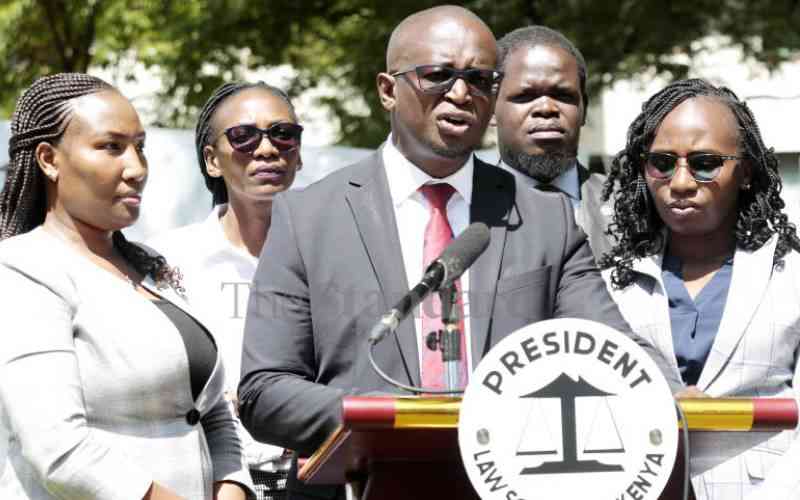The vital role punctuation marks play in giving meaning, direction and flow to any writing cannot be over emphasised. A carelessly placed comma, hyphen, semi-colon, full colon or quotation mark can significantly alter the intended meaning.
Commas are used to introduce a new part to a sentence. The semi-colon is used to join two sentences, and can be used in lieu of a conjunction. The full colon is used to introduce a clause that explains the preceding one. For instance, ‘He carried the whole war chest: machetes, arrows, bows and spear’.
A passage taken from a newspaper editorial last week serves to illustrate the importance of correctly placed punctuation marks: “Kenya is a remarkable country, made up of diverse communities”, said President Kenyatta Sunday who share an anthem and a flag but most importantly share a country.
We share schools, hospitals and wards, and contribute to each and every other person’s elevation and our shared quality of life”. Ideally, a double quotation mark is used to show where a quoted text begins and ends, to distinguish it from the writer’s own work.
Formless sentence
In the quoted passage above, immediately after the words ‘said President Kenyatta yesterday’, a comma to mark the end of the brief interlude and the double punctuation mark to mark the resumption of the quoted text are missing. In effect, the passage becomes formless.
That omission, having clearly altered the message, emphasises the prudence in letting a quote run fully without interruption.
This, however, is not a requirement of the language, it simply eliminates errors like the one highlighted. While preceding a quote with ‘Mary said’ is perfectly in order, it assumes the passive form. Thus, starting off the quote and attributing it later, ‘said Mary’ takes on the active form, hence preferable.
Ambiguity, a topic visited in an earlier column, denotes the state of being subject to more than one interpretation. There are times a writer can deliberately resort to ambiguity when he or she seeks to avoid some unpleasantness, but such a writer would always be careful to lead his readers to the desired conclusion.
The biggest cause of deliberate ambiguity is the fear of libel suits. In Kenya, particularly, speaking some truth to the moneyed and politically well-connected is dicey business.
That is the exception, though. The rule is to avoid ambiguity as much as possible. Consider the following newspaper headlines espied last week. ‘US gunfire kills Afghan father and his two sons’. This raises the questions, who is US in this case?
The ‘who’ comes in logically because of the action of firing guns. Second, is there ‘gunfire’ unique to the ‘US’, assuming one automatically interprets the acronym to mean the United States? A more appropriate headline would have been ‘US Army gunfire kills father and two sons in Afghan’. It is the word ‘Army’ that gives the sentence exactness.
Subject, verb and object
Yet another headline read ‘Suspected diarrhoea kills 279 people in Sudan’. How does one begin to suspect diarrhoea? If by restricting ourselves to taking ‘suspect’ to mean ‘the accused’, ‘the defendant’ or ‘the respondent’, does that make diarrhoea ‘somebody’?
All these suppositions arise because the headline writer neglected to place his choice of words in the correct order. ‘Diarrhoea suspected to have killed 279 people in Sudan’ does not leave room for doubt; something to do with SVO(subject, verb and object)
Stay informed. Subscribe to our newsletter
A photo caption reading ‘senior advisor to the president Jared Kushner holds one of his children on the tarmac of Andrews Air force base in Maryland, on Sunday’, must have left readers with some questions. Because ‘the’ is definite, and there is a comma missing after the word ‘president’, it follows that Kushner is the president.
Had the comma been there to introduce the other clause, it would have automatically implied that Kushner is the advisor. And then there is the matter of the child. Because there was only one child visible in the photograph, it was unnecessary to add ‘one of his children’. Suffice it to have just written, ‘Kushner holds his child while on the tarmac’ at (not of) Andrews Air force base’.
There is more ambiguity to be found in the following sentence; ‘Kenya Power staff in Garissa town yesterday roughed up journalists from two media houses as residents protested their poor service delivery’. Were the residents protesting their ‘own’ poor services, those of ‘journalists’ or those of the ‘Kenya power staff’?
Mr Chagema is a correspondent at The [email protected]
 The Standard Group Plc is a
multi-media organization with investments in media platforms spanning newspaper
print operations, television, radio broadcasting, digital and online services. The
Standard Group is recognized as a leading multi-media house in Kenya with a key
influence in matters of national and international interest.
The Standard Group Plc is a
multi-media organization with investments in media platforms spanning newspaper
print operations, television, radio broadcasting, digital and online services. The
Standard Group is recognized as a leading multi-media house in Kenya with a key
influence in matters of national and international interest.
 The Standard Group Plc is a
multi-media organization with investments in media platforms spanning newspaper
print operations, television, radio broadcasting, digital and online services. The
Standard Group is recognized as a leading multi-media house in Kenya with a key
influence in matters of national and international interest.
The Standard Group Plc is a
multi-media organization with investments in media platforms spanning newspaper
print operations, television, radio broadcasting, digital and online services. The
Standard Group is recognized as a leading multi-media house in Kenya with a key
influence in matters of national and international interest.









